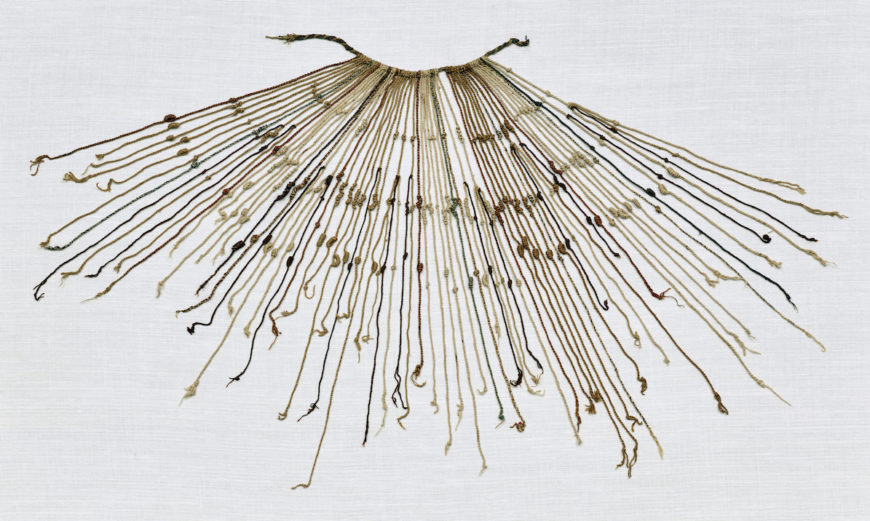
Khipu (quipu) fragment with subsidiary cords, Inka, 1400–1570, cotton and indigo dye, 66.04 × 101.28 × 1.91 cm (Dallas Museum of Art)
The Inka of the Andean region of South America developed the largest native empire in the Americas, a region that included mountains, jungles, and desert coasts. They built impressive monuments and ruled diverse peoples, yet they did this without a way of writing. What the Inka did use was the khipu (or quipu in Spanish), a knotted string record-keeping device, leading some people to ask: what really is writing anyway?
Writing without words
Inka khipus are bundles of woolen cords tied together with knots added to them to encode information. Some are all a natural beige cotton color, while others feature elaborate color combinations. Khipus are read from the looped, left side of a thick cord to the loose right side, with thinner knotted cords hanging down like long fringe. They were made, kept, and read by khipukamayoq, administrators who helped to rule the Inka empire by recording and keeping the information contained in the khipu.
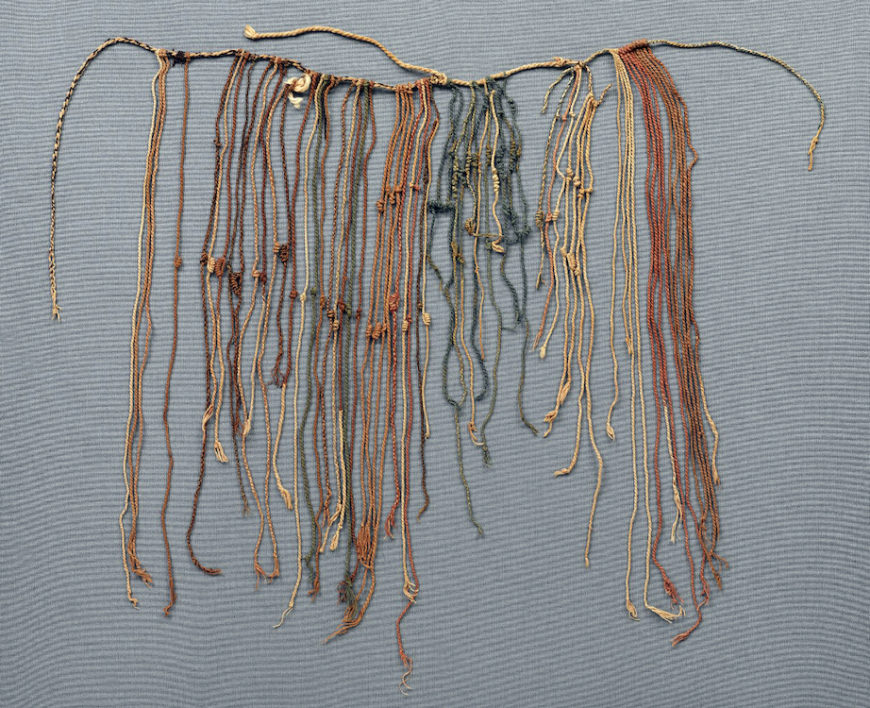
Khipu, Inka, 1400–1532, cotton, 39 x 77 cm (The Brooklyn Museum)
Similar recording systems made of fiber cords appear to have been used prior to the emergence of the Inka (pre-1300s C.E.) until well after the dissolution of the Inka empire (after the 1530s C.E.). In the native language of Quechua, “khipu” means “knot.” But figuring out whether these knots should be considered a form of writing cannot be answered until people today learn how to read the khipus of the past. Writing is graphic representation of a spoken language—symbols that can be translated into meaning originally expressed in speech. Some scholars have called the khipu “writing without words.” What is clear, however, based on centuries of research by mathematicians, textile artists, anthropologists, archaeologists, historians, and others, is that khipus recorded and conveyed complex information of many types. Today, we are able to read the numbers knotted into most khipus, even if we don’t always know what they are counting.
Khipus recorded information about taxes and inventories, but also about time and calendric cycles. They reportedly recorded laws, judicial proceedings, and perhaps historical narratives. Even though the khipukamayoq read them in Inka times, these ancient objects cannot be fully read today. Some khipus have been described by khipu makers living in the 20th century who preserved local methods of recording, but those methods do not seem to apply to all Inka khipus.
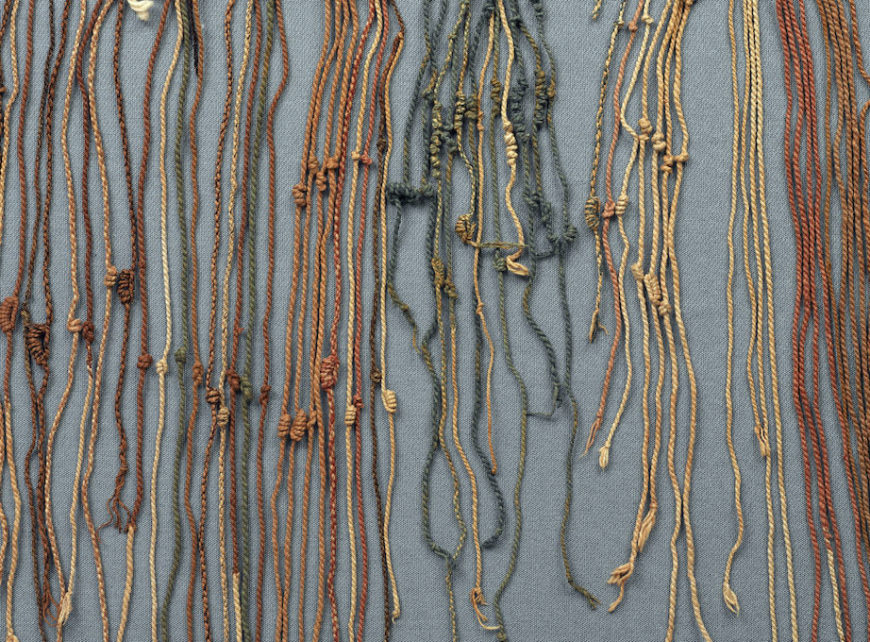
Khipu, Inka, 1400–1532, cotton, 39 x 77 cm (The Brooklyn Museum)
One problem is that khipu literacy was not accurately documented from the 1500s forward, which was the time in which Europeans attempted to record Inka histories after the Spanish invasion and conquest began in the 1530s. The Indigenous chronicler Guaman Poma de Ayala wrote in a 1615 letter to the King of Spain that “with the strings they governed their entire dominion,” and he exalted the khipukamayoqs for their ingenuity and skill.
Yet the Spanish Colonial chroniclers who described the khipu and its functions contradicted each other. Some claimed they were composed of letters, while others claimed they were mnemonic (memory) devices without a consistent method of encoding information. The chronicler Garcilaso de la Vega (a descendant of both Inkas and Spaniards) wrote in the early 1600s that the khipu recorded numbers—not words—from which the record-keepers memorized historical events. He also wrote that some read the khipu to recount poetry and allegories. Amid these inconsistent characterizations by early chroniclers, the Spanish campaigns to extirpate idolatry resulted in them publicly burning some of the Inka khipus in 1583.
More recently, many researchers have agreed that khipus seem to not have a single, standardized language system. However, they have identified some groups of khipus that have matching segments in which groups of cords have the same or similar knotted numbers from one khipu to another. These khipu may have counted local people or goods repeatedly, and may have been encoded in the same way from one khipu to another in that place. If there was not an empire-wide recording system, then maybe khipukamayoqs from single villages or regions did use the same coding system.
The nature of these khipu groups demonstrates that administration and accounting must have been at least one purpose of khipu. Such records may have included censuses, labor taxation, troop movement, storehouse counts, and more. The Inka structure for governing peoples in their provinces organized them into bureaucratic units based on fives and tens (such as 50, 100, 500, etc.), often called decimal administration. Khipu structure and organization shows how they could have been tools for counting and administering populations: a khipu’s knots are organized vertically by 1s, 10s, 100s, and more. Also, pendant cords (hanging from the main cord) are often grouped in fives and tens. With different ethnic groups speaking diverse languages across the vast Andes, a system to track and account for millions of people and their labor and goods would have been useful.
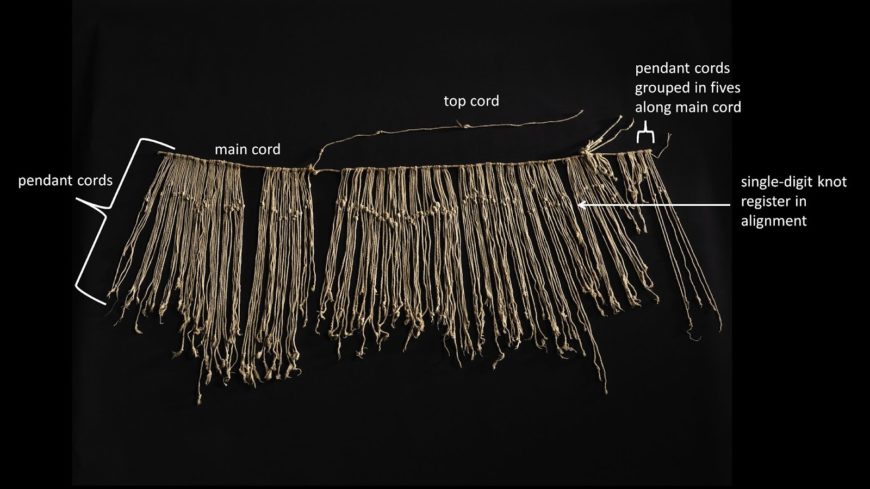
Main elements of a khipu. 2002.1.118 (© Michael C. Carlos Museum, Emory University; photo: Bruce M. White, 2011)
Building an empire in string
The basic structure of a khipu most commonly consists of a main cord, pendants hanging from the main cord, as well as additional elements attached to pendants and main cord. The main cord is oriented horizontally, and one reads from the looped left side toward the loose right side of the main cord. Along its length, pendant strings are securely looped on to hang vertically downward. There may be one or more top cords, which would not hang downward but are rather tied on to sit upward if pulled away from the main cord. Many top cords summarize the information in the pendants, as their knots often represent the arithmetical sum of all the pendant cords hanging below.
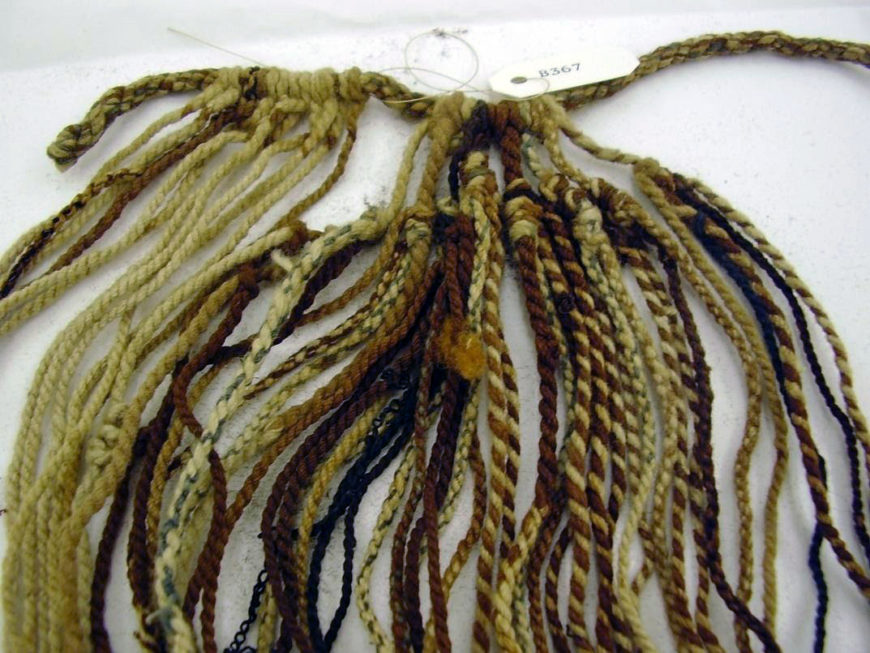
Example of multiple subsidiary pendants hanging from pendants (Dallas Museum of Art; photo: Dr. Kylie Quave)
Some pendant strings include subsidiary pendants also tied on to the original primary pendants that hang below the main cord—making up secondary, tertiary, and quaternary pendants, and so on. These subsidiary cords may be corrections, exceptions, or subsets of information. Those who wrote and maintained khipus must have revised them at times, as some have bends in the pendant strings that suggest they were un-knotted or re-knotted.
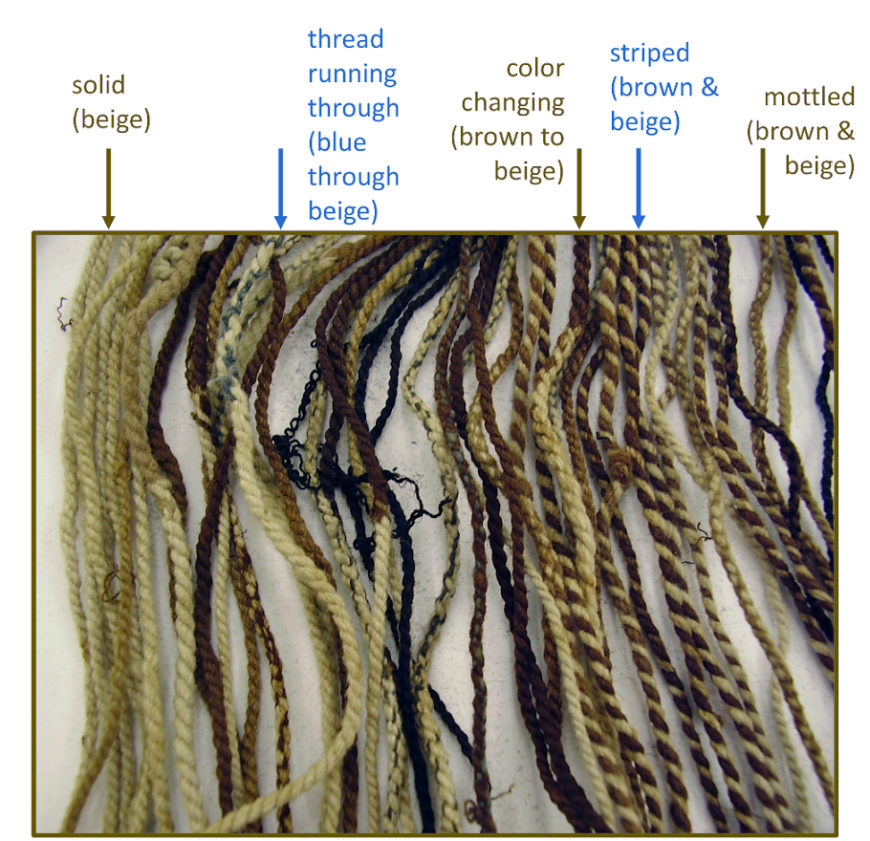
Examples of color combinations from a khipu. Note that these pendants are all S-plied (Dallas Museum of Art; photo: Dr. Kylie Quave)
Khipus are most often made of camelid fiber, cotton, and other vegetal fibers that have been spun and plied. Both natural colors and colors achieved through dyes are found on khipus and other Andean textiles. Colored fibers are spun and plied together to make mottled or striped effects. Some khipu cords contain a single strand of a contrasting color, or the cord changes color mid-string. Spanish chroniclers writing in the 1500s and 1600s claimed that khipu colors held particular meanings, and researchers find it plausible that specific types of khipus each had their own suite of color symbols.
Once cords are prepared, the main cord and pendant cords are attached to each other. Pendants can be looped in one direction or another to attach, a decision that likely carries meaning within some khipus, just as the spin and ply directions of the cords likely carry meaning.
The knots tied onto khipu pendants can signify numerical and non-numerical information. There may be just one horizontal row (or register) of knots on pendant strings, but some khipus have several rows of aligned knots. Some of those rows of knots are organized in a decimal (or base-10 hierarchy), with the lowest row (farthest from the main cord) representing the 1s place, the next up as the 10s, then the 100s, the 1000s, and so on. Within each register, there are specific types of knots signifying numerical values. Today we count in a decimal system as well, but we use Arabic numerals. In our system, the ones place is to the right, and each digit goes up by a multiple of ten to the left (in the number 345, the 5 is in the ones place, the 4 in the tens place, and the 3 in the hundreds place). For the khipu, this decimal hierarchy goes from lowest row to highest row instead of right to left.
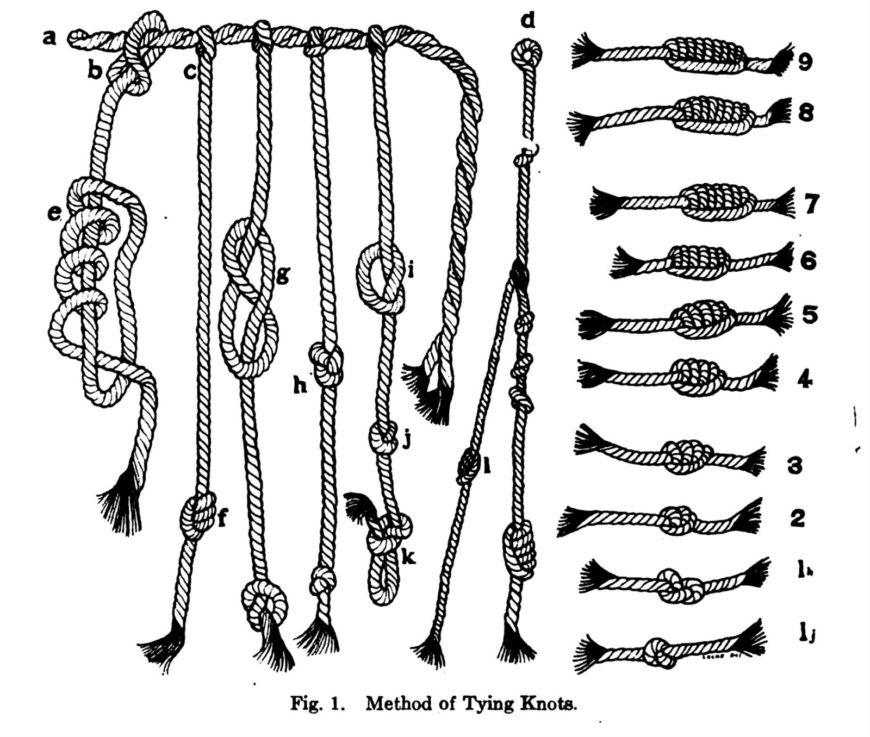
Knots e-f are long knots (values 2-9), knots g-h are figure-eight knots (value 1), and knots i-j are single overhand knots (10s, 100s, etc.) Drawing of knot-tying methods from L. Leland Locke’s landmark work The Ancient Quipu or Peruvian Knot Record (1923: fig. 1, American Museum of Natural History, New York).
Numerical khipus
Numerical value-signifying knots are formed in three ways. For single digits, they include: a “figure-8” knot for a value of “1”; or a “long knot”, which includes two to nine twists around its cord for the values 2-9 (see the diagram above). To signify tens, hundreds, and more in a decimal system, khipus include single overhand knots. Just one overhand knot in the tens row would be a 10 value, while two or more overhand knots in a cluster would indicate 20 to 90. In the hundreds row, they would indicate 100, 200, and so on. Each row on a numerical khipu has a value of up to 9, 90, 900, and so forth. The total value of that pendant is found by adding each row. For example, in the diagram above, string d has a value of 135: there is a single overhand knot in the 100s row at the top (100), three single overhand knots in the second row (30), and a long knot with five turns in the lowest row (5).
Narrative khipus
Khipus that diverge from the decimal and numerical organization of knots are referred to as “narrative” khipu. These lead to complicated questions about how to read (and write) them. While it is possible these khipus functioned as mnemonic devices, there are alternative possibilities. One system could entail elements of the khipu translating to portions of words in Quechua, the language of Inka state business. Another system could mean that elements of a khipu encode something other than words, like a pictographic form of writing in string.
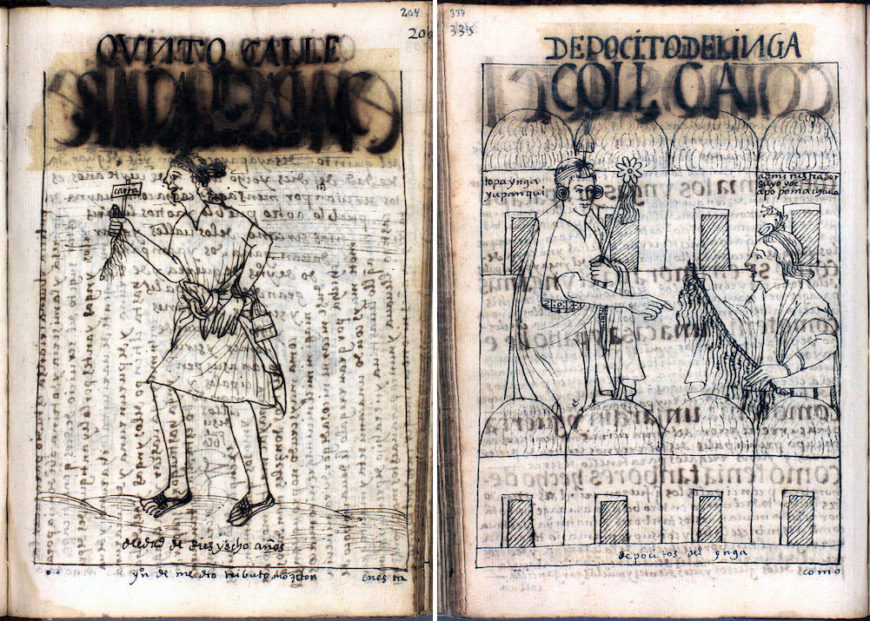
An Inka messenger carries a khipu in his hand (left), and a khipukamayoq and Inka ruler in front of storehouses (right), from Felipe Guaman Poma de Ayala, The First New Chronicle and Good Government (or El primer nueva corónica y buen gobierno), c. 1615, p. 202 [204] and p. 335 [337] (The Royal Danish Library, Copenhagen)
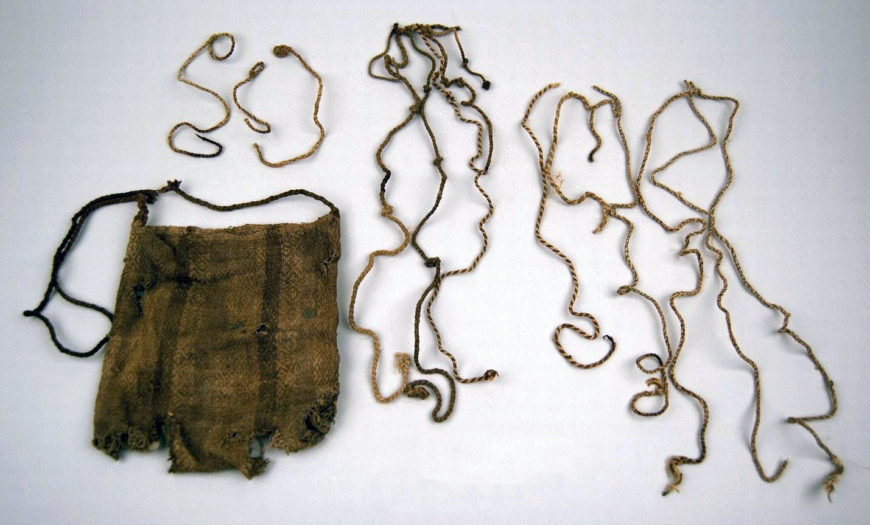
A woven Inka bag, inside which was found a fragmented khipu and loose pendant strings. This bag and its contents were recovered near modern Lima, Peru, as part of a group of mortuary goods likely belonging to an Inka bureaucrat (Logan Museum of Anthropology, Beloit College)
The future of the khipu
More than 600 khipus have been catalogued in detail for visual and statistical comparisons. The majority are found in museum and private collections, which means many have been separated from their original archaeological contexts. Archaeological khipus are not likely to survive in high-altitude regions, like the Inka capital of Cuzco in the high Andes, where organic fibers rarely survive within the earth. This presents another challenge to deciphering khipus.
However, khipus are not only found within the earth of archaeological sites or in art collections; they are still used in Andean communities today. The Indigenous descendants of the Inkas and the peoples they governed continue to live in the Andes. In the last 500 years since the Spanish invasion, khipus have been used to count flocks of animals and to track offerings and payments related to Catholic Masses and festivals. In some places, khipus have been created to accompany deceased loved ones into the afterlife. This tradition had been in decline, but resurged with the COVID-19 pandemic. Practitioners believe that the khipu animates the dead, and the rebirth of this tradition has brought comfort amid the grief of so much sudden loss.
Khipu makers may explain their ways of writing today, but those ways do not translate well for reading the Inkas’ khipus. As khipus seem to have been key for managing a geographically large and extraordinarily diverse population of millions of people speaking multiple languages, determining how they functioned is essential if we want to understand the Inka empire.
Additional resources:
A Spanish and English bilingual book of essays and catalogue of khipus: Setlak, Magdalena, Viviana Moscovich, Sabine Hyland, and Lucrezia Milillo Quipus y Quipucamayoc. Codificación y Administración En El Antiguo Perú / Quipus and Quipucamayoc, Encoding and Administration in Ancient Peru (EY PERU/APUS GE, 2020)
Manny Medrano explains what researchers know about khipus (en español)
Video on khipu structure from MALI (Museo de Arte, Lima, Peru)
Ashok Khosla’s Khipu Field Guide renders khipus into digital diagrams for comparison
More on the resurgence of khipus since 2020 from Sabine Hyland, Christine Lee, and Roberto Aldave Palacios

